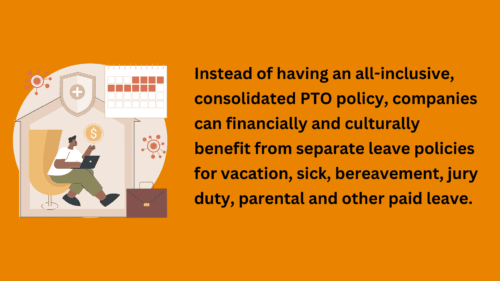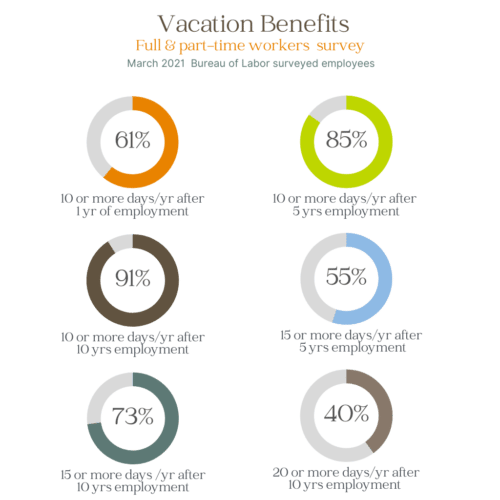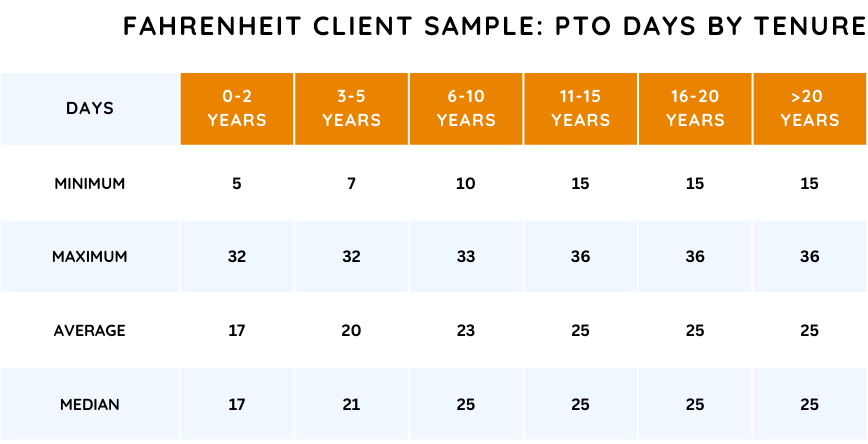How PTO Affects Recruitment and Retention – Part 1 of 2

Explore the risks and benefits of unlimited PTO policies in this first of two articles about PTO’s influence on recruitment and retention.
We’ve all heard about it… The Great Resignation, The Great Reshuffle, The Great Reevaluation, and Quiet Quitting. Whatever you call it, it’s left a lasting impression on companies and workers, even as the economy starts to cool. Unemployment remains below pre-pandemic levels, and there are more open positions than workers available.
Organizations must put forth their best efforts to recruit and retain quality workers. Many companies are considering changes to paid time off policies to effectively entice and engage talent. Work-life balance is of the utmost importance to the modern workforce, and generous paid time off policies support employees’ needs and desires for a harmonious professional and personal existence, especially when remote work is not possible.
The great debate for employers is:
- How much paid time off is enough?
- How much paid time off can the company support financially while still accomplishing its mission and goals?
- What are the new norms and the new gold standard for paid time off offerings?
- Does it make sense to offer a consolidated PTO policy or maintain separate leave policies?
- What about unlimited PTO?
In part one of two articles related to this topic, I will cover the unlimited PTO option, providing enough time off, and consolidated PTO.
Is unlimited PTO a viable solution?
Surprisingly, many of the companies who instituted unlimited PTO early on are returning to traditional PTO polices. While unlimited PTO seems like a dream situation for employees, in reality these plans can add unexpected stress on employees and managers. Often employees on unlimited PTO policies are fearful of being seen as taking ‘too much time off’ and ‘taking advantage of the system.’ This results in employees taking too little time off to address their personal needs (even less than they usually were awarded under traditional PTO policies), ultimately resulting in greater potential for burnout. Additionally, managers have the added stress of more difficult conversations with employees to advise them that they are not meeting performance goals and unfairly affecting their team because of ‘taking too much time off’ – a fine line that’s often moving and can be applied inconsistently, potentially unfairly, or in a seemingly discriminatory way.
If your company operates in a state or locality that requires pay out of accrued but unused paid time off (such as California and Colorado), be especially careful that your unlimited PTO program does not have an implicit or explicit expectation that only a certain number of days or weeks off is expected or accepted. Case law has resulted in greater liabilities for unlimited PTO programs that are not truly administered as unlimited because the company can be responsible for an indeterminate amount of PTO payout when employees leave the company.
Consolidated PTO vs. Separate Leave Policies
Instead of having an all-inclusive, consolidated PTO policy, companies can financially and culturally benefit from separate leave policies for vacation, sick, bereavement, jury duty, parental and other paid leave. The ease of administration for consolidated PTO is a great benefit to the company, but many employees feel that PTO is for vacation and other personal reasons. Employees can become disengaged when they are expected to use their limited PTO for unexpected illnesses and deaths in the family, instead of desired personal time. Plus, if employees are eligible for unlimited PTO, there’s a conundrum of how to legally and appropriately administer unpaid FMLA, other medical or family leaves of absence, or extended personal leaves of absence.
I may be in the minority here, but I’m not opposed to using the term ‘PTO’ while still having separate sick and other leave policies. The term ‘PTO’ is trendier than ‘Vacation’ and it’s more inclusive of the ability to use the designated time for all personal needs, not just planned vacations. In this circumstance, the acronym ‘PTO’ could even be considered ‘Personal Time Off,’ instead of the more accepted term ‘Paid Time Off.’
How much is enough?
There is no federal requirement for a private employer to offer vacation or personal time off, but the majority of all employees, full-time and part-time, have access to some sort of paid leave benefits, including vacation or PTO. To be considered an employer of choice and attract and retain employees in today’s market, you must offer generous paid time off policies or some other attractive benefit to employees.
In March 2021, the Bureau of Labor Statistics surveyed employees about vacation benefits they receive (not including sick time), despite no federal or state requirement on employees to offer this paid time off benefit. You may be surprised to hear that 95% of all manufacturing and financial activities employees have access to paid vacation leave. At least 80% of all construction, education, health services, information, professional services, trade, transportation, and utilities employees have access to paid vacation leave, while only 43% of leisure and hospitality employees have access to paid vacation leave.
In this BLS report on vacation benefits:
- 61% of all workers, full-time and part-time, received at least 10 days of vacation leave annually after their 1st year of employment
- After 5 years of employment
- 85% of all employees receive at least 10 days of vacation annually
- 55% receive at least 15 days of vacation annually
- After 10 years of employment:
- 91% of employees receive at least 10 days of vacation annually
- 73% receive at least 15 days of vacation annually
- 40% receive at least 20 days of vacation annually
Based on a sampling of Fahrenheit Advisors’ clients, we identified some standards for current paid time off policies, which included vacation, sick, personal, and PTO leave, but excluded holidays, bereavement, jury duty, and other types of paid leave.
- Most companies use seniority brackets for allotment of PTO and vacation, but the brackets often max out at 15+ years.
- Less than 10% of employers sampled offer unlimited PTO policies.
In part two of this series on using PTO as a recruitment and retention strategy, we will discuss new standards for all the other types of paid leave to be considered by employers, including: sick, bereavement, jury duty, volunteer, parental, family and medical leave, in addition to holidays and part-time leave benefits.
There are many facets to consider when addressing the impact of paid leave policies. There may be local, state, and federal laws that impact your business’ decision. The experts at Fahrenheit Advisors stand ready to help you move straight forward through these complicated business decisions. Reach out to our team at Experts@FahrenheitAdvisors.com.
About the Author
 As a Strategic HR Business Partner and Senior HR Consultant, Jennifer Bartlett brings 20+ years’ professional experience in Human Resources, Leadership, Administration, Marketing, Education and Law to Fahrenheit. She is dedicated to providing excellent service, counsel and leadership to clients, executives, managers, employees, candidates and customers. Her experience ranges from for-profit, individually owned, private equity backed, publicly traded, start up, public and non-profit multi-state companies (including California). She is a subject matter expert in all aspects of HR including recruitment, retention, on-boarding, employee relations, employee engagement, performance management, training and development, benefits and payroll administration, compensation, legal compliance, and strategic organizational planning.
As a Strategic HR Business Partner and Senior HR Consultant, Jennifer Bartlett brings 20+ years’ professional experience in Human Resources, Leadership, Administration, Marketing, Education and Law to Fahrenheit. She is dedicated to providing excellent service, counsel and leadership to clients, executives, managers, employees, candidates and customers. Her experience ranges from for-profit, individually owned, private equity backed, publicly traded, start up, public and non-profit multi-state companies (including California). She is a subject matter expert in all aspects of HR including recruitment, retention, on-boarding, employee relations, employee engagement, performance management, training and development, benefits and payroll administration, compensation, legal compliance, and strategic organizational planning.



